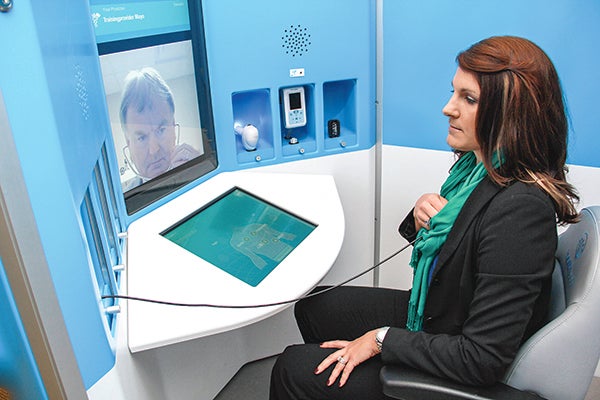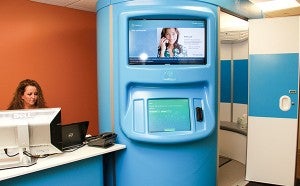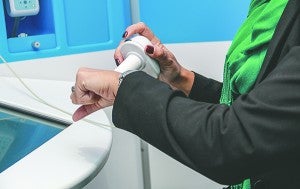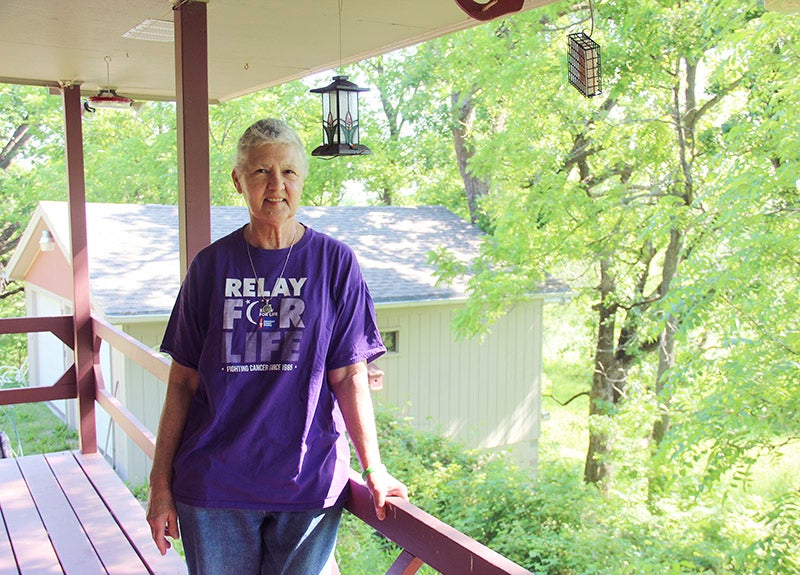The Mayo doctor will see you now
Published 9:59 am Friday, October 10, 2014

Clinical Operations Manager Melissa Barr demonstrates how an electronic stethoscope works in the HealthSpot kiosk at Mayo Clinic Health System in Austin Thursday as Operations Administrator Scott Ramsey listens from several rooms away. The kiosk will allow patients to be treated for acute care via teleconferencing. The Austin clinic is the pilot side for the Mayo Clinic Health Connection program and will begin by treating Mayo employees and dependents only later this month. – Jason Schoonover/Albert Lea Tribune
Kiosk allows teleconferencing
By Jason Schoonover, Austin Daily Herald
AUSTIN — Clinical Operations Manager Melissa Barr sat inside a blue, walk-in kiosk on the second floor of Mayo Clinic Health System in Austin Thursday as Operations Administrator Scot Ramsey appeared on a video screen and listened to her heart through an electronic stethoscope from several rooms away.

The kiosk will allow patients to be treated for acute care via teleconferencing. The Austin clinic is the pilot side for the Mayo Clinic Health Connection program and will begin by treating Mayo employees and dependents only later this month. – Jason Schoonover/Albert Lea Tribune
Their demonstration showed the latest step in a way Mayo is looking to bring care to patients in a cutting-edge way. Mayo Clinic Health System in Austin is the pilot site for a project called Mayo Clinic Health Connection, which allows patients to be treated for basic care via teleconference through the HealthSpot platform.
A health provider, who can be anywhere with a laptop and the Internet, will see patients inside the private, walk-in kiosk that provides high-definition videoconferencing and interactive, digital medical devices.
“It’s convenient so it increases access for patients,” Austin and Albert Lea CEO Mark Ciota said. “And it should reduce the cost.”
Clinic officials first started discussing the HealthSpot idea about a year ago when an administrator saw the unit at a conference. Austin staff have started using the unit for practice and demonstrations, and they hope to see the first live patients later this month. To start, the unit will only be available to Mayo Clinic Health System in Austin and Albert Lea employees and dependents.

Clinical Operations Manager Melissa Barr demonstrates how a dermascope works in the HealthSpot kiosk at Mayo Clinic Health System in Austin Thursday. The kiosk will allow patients to be treated via teleconferencing. The dermascope allow a provider to look at a patient’s skin, eyes and throats from anywhere with a laptop and the Internet. – Jason Schoonover/Albert Lea Tribune
But administrators say such kiosks could eventually be used at workplaces to provide easy access to healthcare, and it could help businesses keep healthcare costs down.
“It’s a way to provide care in locations we haven’t been able to access before,” Ciota said. “People access us in a different way, and long term, that should be a lower cost, but maintaining the same quality that we have already.”
The system will connect patients to doctors and nurse practitioners at Mayo Health System site in Austin and Albert Lea, but could one day connect the patients at Mayo sites across the country.
Administrators say it could be a win-win for the medical center and businesses.
“It allows patients to get the treatment they need in a timely fashion without interrupting their whole day,” Ciota said. “Then it allows us to start to offer access to our services in a way that we haven’t been able to do in the past.”
How it works
While cellphone apps and home Internet sources offer patients the option to talk to a health provider, they lack in interaction, which Ciota said sets the HealthSpot unit apart.
“It’s the next step up,” he said.
“The level of engagement is really high,” Barr added, as she noted patients can see everything the provider does.
Though conducted through video conference, a checkup to a HealthSpot kiosk still will go through the usual steps, along with a few new ones.
First, a patient logs in and enters personal information before selecting from a list of conditions on a screen outside the kiosk — like cough, allergies, vomiting/diarrhea, sore throat, cough, etc. Then he or she answers questions about the severity and if he or she had been exposed to someone who is sick. If the answers indicate a condition is severe enough, the unit would redirect the patient to a different part of the clinic. After answering questions, the screen will say when the next available appointment is.
Once inside, there’s space in the back of the kiosk to get a patient’s height and weight. Then at a chair by the main conferencing screens, there are several drop down panels controlled by the provider with a stethoscope; a thermometer; a dermascope; an otoscope to look inside an ear, nose or throat; and a pulse oximeter to monitor oxygen saturation of the blood and the patient’s pulse.
Rather than the doctor administering these tests, the patient uses the equipment on himself or herself as instructed by the provider, who monitors and receives results electronically.
The provider appears on a center screen via webcams. Two other screens, one blow and one above the provider screen, show the patient’s information: height, weight, heart rate, blood pressure and more.
Barr, posing as a patient, demonstrated the dermascope — used to look at skin, eyes or the back of the throat — by holding it to her hand and then her pants. First, her skin and then the fibers of her pants appeared split on the screen with Ramsey, who was posing as the provider. Ramsey could circle things he found on the images to show Barr what he found.
An attendant sits at a desk outside the unit and helps if the patient needs assistance. The unit is enclosed for privacy, and Operations Administrator Tammy Kritzer assured the unit is thoroughly sanitized after each use.
Doctors and nurses connect with standard laptops equipped with a webcam, a type of speaker phone and headphones for listening to patients’ hearts.
After the appointment, medical information is stored electronically, and a prescription is sent electronically to a pharmacist of choice.
“You can get everything you need, you can visit a doctor, you can get a prescription printed somewhere else,” Ciota said.
Right now, the unit is slated for acute care and basic conditions, but Ciota said it could one day be used for mental health or counseling services.
Before using it with patients, staff members wanted to make sure they understood how it worked, resolve any issues, make sure the IT connections are secure and learn about things like disinfecting the equipment.
Mayo is aiming to have about 12 health providers participate in the pilot program. All will go through training for operating the web-based system.
This unit is the first of its kind in Minnesota, to the knowledge of Mayo leaders. Ciota admits this will be a learning process for staff too.
“We’ll learn every time we see somebody,” he said.
Future expansion
After using the unit to treat staff and dependents, administrators will look for options to using the unit and potentially additional units best in the future.
It may not be long until units are used at local employers.
“We hope to roll out other kiosks with partners in those areas sometime here in the very near future,” Ciota said.
The idea of taking health care directly to workplaces is becoming more common, especially in light of rising healthcare costs.
In 2013, Quality Pork Processors built its own clinic for employees. In May, the Herald ran a story on Austin Public Schools looking into a partnership with Mayo to build on-site clinics at schools.
While administrators did not name any potential HealthSpot partners Thursday, Ciota said the kiosks would help businesses increase productivity.
“You can bring the health care to the sites,” he said. “An employee would not have to leave the business site to get their care, which of course would decrease their time away from work, which would increase their productivity. That is one of the benefits.”
While the first unit is in Austin, administrators say the units could eventually be used at other Mayo Health System locations.
“We are optimistic that we will be able to expand this,” Kritzer said.





